Dopo anni di costruzione di siti web WordPress, abbiamo imparato quanto sia importante avere una configurazione locale di WordPress sul proprio computer.
Avere WordPress sul vostro computer personale vi permette di sperimentare nuove funzionalità senza rischiare il vostro sito live, di immergervi in profondità nello sviluppo di WordPress e persino di costruire interi siti web prima che diventino operativi. È come avere una sandbox privata per tutti i vostri progetti WordPress.
Se siete utenti Windows, esistono numerosi modi per configurare WordPress in locale. Ma abbiamo ristretto il campo ai due metodi più semplici. In questa guida vi mostreremo come installare facilmente WordPress su un computer Windows, indipendentemente dalla versione in uso.
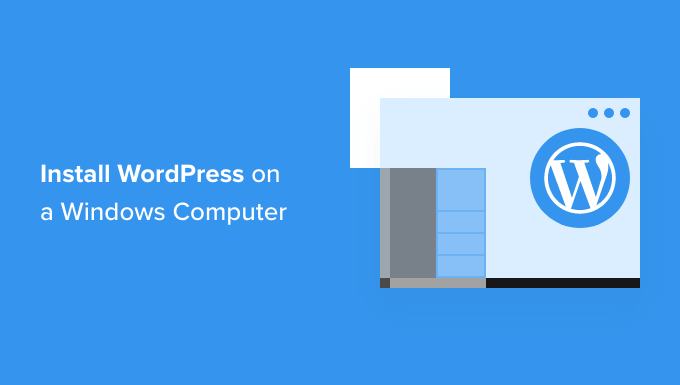
Perché installare WordPress su Windows?
Se siete utenti di Windows, l’installazione di WordPress in locale sul vostro computer offre diversi vantaggi.
Un’installazione locale di WordPress crea un ambiente di prova che non influisce sul vostro sito web reale. Questa configurazione, spesso chiamata server locale o localhost, è il vostro parco giochi personale per WordPress.
Gli sviluppatori di WordPress utilizzano regolarmente installazioni locali per il loro lavoro. Ad esempio, possono usarle per sperimentare nuovi plugin o temi o per testare il sito prima di aggiornare l’editor di blocchi Gutenberg.
Ma non è solo per i professionisti. Se siete alle prime armi con WordPress, una configurazione locale è perfetta per imparare. Potete esplorare le funzionalità, testare temi e plugin e sperimentare liberamente senza preoccuparvi di rompere un sito live.
È importante notare che quando installate WordPress in locale su Windows, solo voi potete vedere il sito. Se volete creare un sito web pubblico, avrete bisogno di un nome di dominio e di un hosting web.
Ora, tecnicamente, è possibile installare WordPress su Windows utilizzando XAMPP, e abbiamo già scritto un tutorial al riguardo.
Detto questo, abbiamo trovato due metodi ancora più semplici di XAMPP per configurare un ambiente WordPress locale, ideali per i principianti o per gli utenti che hanno bisogno di creare rapidamente un sito locale. Potete fare clic sul link qui sotto per passare al metodo che vi interessa:
Metodo 1: Installare WordPress su Windows utilizzando Studio (semplice e veloce)
Per il primo metodo, utilizzeremo Studio. Si tratta di un software locale per WordPress realizzato da Automattic, la società che gestisce e amministra WordPress.com, che è un costruttore di siti web basato sul software WordPress.
Parleremo prima di questo metodo perché è molto più rapido e semplice da seguire, perfetto per i principianti.
Innanzitutto, è necessario aprire il sito web di Studio by WordPress.com. Quindi, fate clic sul pulsante “Download per Windows”.
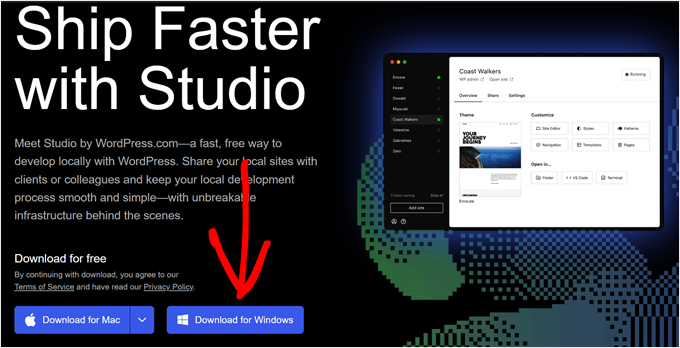
Una volta fatto ciò, basta aprire il file scaricato per avviare l’installazione.
A questo punto apparirà una finestra popup che indica che l’applicazione è in fase di installazione.
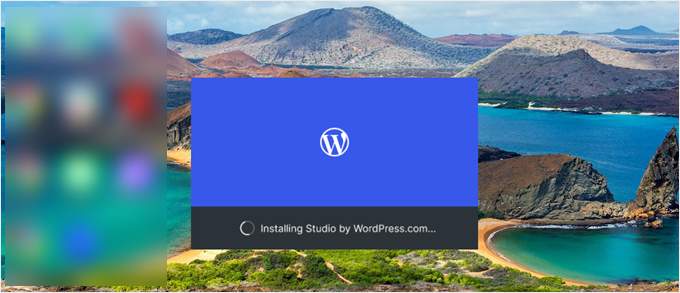
Fatto questo, si può aggiungere il primo sito.
Per farlo, basta inserire il nome del nuovo sito WordPress locale e fare clic su “Aggiungi sito”. Potete dare al sito il nome che preferite, purché vi aiuti a identificarlo facilmente.
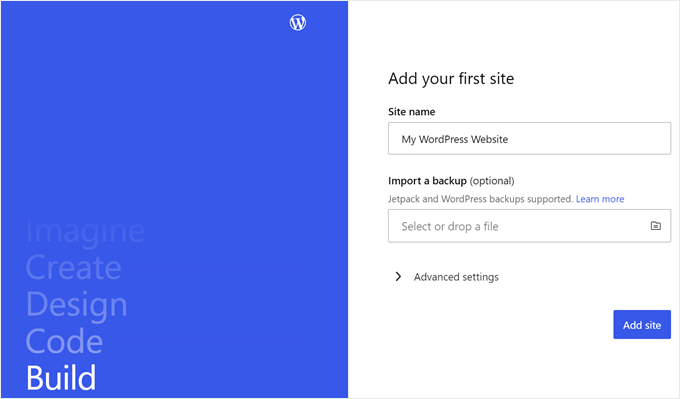
Ora dovreste vedere la dashboard del vostro sito WordPress locale.
Per accedere alla dashboard di WordPress e modificare il sito web, è sufficiente fare clic sul pulsante “Start” nell’angolo in alto a destra. In questo modo il vostro sito web locale sarà accessibile sul vostro computer.
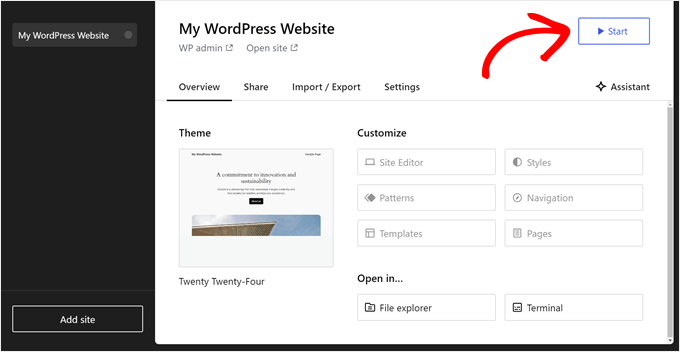
Una volta modificato il pulsante “Avvio” in “In esecuzione”, si può fare clic sul link “WP Admin” in alto a sinistra della pagina.
In questo modo si accede alla pagina di amministrazione locale di WordPress.
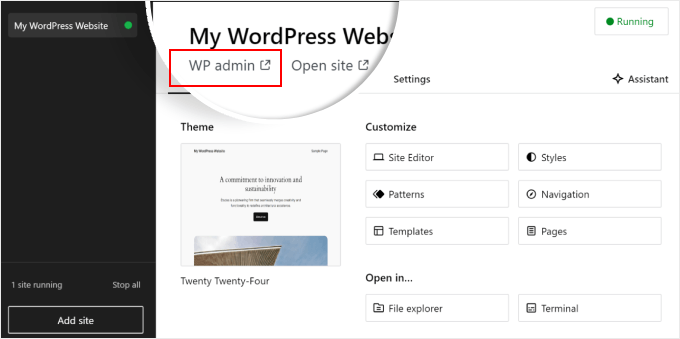
E questo è praticamente tutto per la configurazione. Esaminiamo le altre impostazioni che possono essere necessarie per la creazione del vostro sito web locale.
Come si può vedere nella scheda “Panoramica”, è possibile accedere immediatamente al menu dell’editor completo di WordPress direttamente dalla dashboard di Studio. Potete anche fare clic su “Esplora file” per aprire le cartelle e i file del vostro sito WordPress e fare clic su “Terminale” per gestire il vostro sito web utilizzando WP-CLI.
Se passate alla scheda “Condividi”, potete accedere al vostro account WordPress.com, clonare il vostro sito web locale e caricarlo sui server di WordPress.com. In questo modo il sito clonato sarà temporaneamente online, il che è utile per condividere siti demo con i vostri clienti o membri del team.
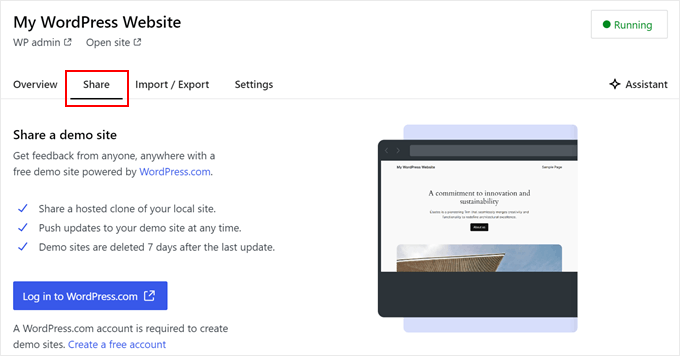
A volte si può desiderare di accedere al proprio sito web locale direttamente tramite il browser, invece di utilizzare Studio. In questo caso, è necessario conoscere le credenziali di wp-admin.
Per trovarli, potete passare alla scheda “Impostazioni” e trovare il nome utente, la password e l’URL di accesso dell’amministratore di WordPress.
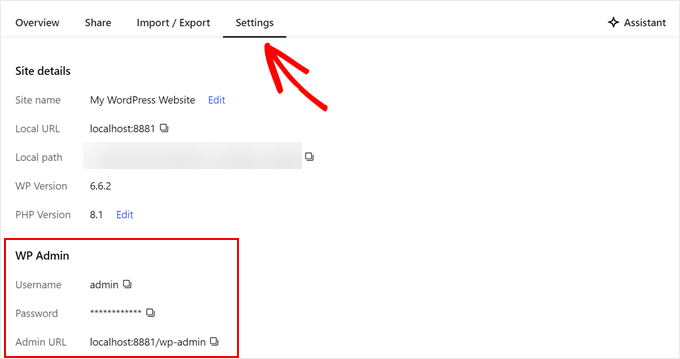
Un’altra caratteristica interessante di Studio è il chatbot AI integrato, con il quale è possibile comunicare facendo clic sul pulsante “Assistente”.
Qui è possibile chiedere aiuto a Studio per compiti come l’aggiornamento di tutti i plugin in una sola volta, l’aggiornamento della versione principale di WordPress o la creazione di codice per un blocco personalizzato.
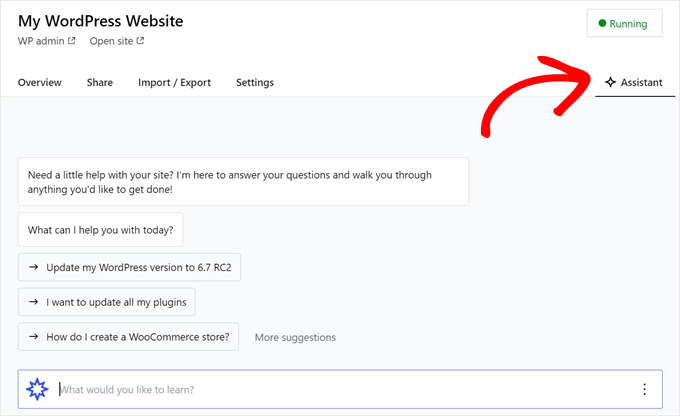
Quando avete finito di lavorare sul vostro sito locale, passate sopra il pulsante “In esecuzione” nell’angolo in alto a destra fino a quando non appare la scritta “Stop”.
Quindi, fare clic sul pulsante per interrompere il sito web.
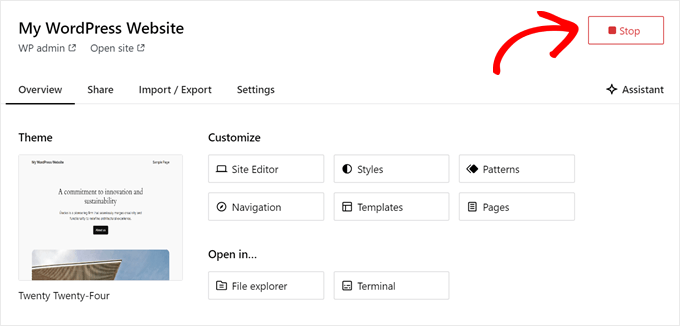
Un aspetto negativo di Studio è che non è possibile configurare l’ambiente WordPress a proprio piacimento. Ciò significa che dovete utilizzare la versione di PHP, il server web e il database che sono stati preselezionati per voi.
Questo può essere uno svantaggio se avete bisogno di testare il vostro sito web o plugin con configurazioni specifiche del server.
Se avete bisogno di un maggiore controllo sull’ambiente WordPress locale o di far coincidere la vostra configurazione locale con una specifica configurazione del server live, potete verificare il metodo successivo che prevede l’uso di WP locale.
Metodo 2: Installare WordPress su Windows utilizzando WP locale (più personalizzabile)
Innanzitutto, è necessario scaricare e installare il software Local WP sul proprio computer Windows. Basta andare sul sito web di Local WP e fare clic sul pulsante “Download for Free”.
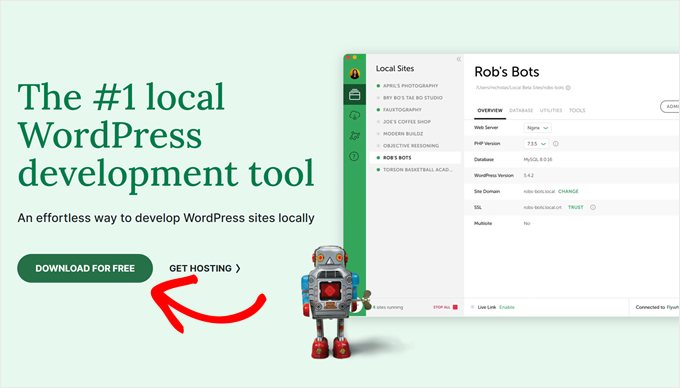
Successivamente, apparirà una finestra popup in cui dovrete selezionare la vostra piattaforma. Scegliete “Windows” dal menu a discesa.
Successivamente, è possibile inserire i propri dati, come nome e cognome, indirizzo e-mail di lavoro e numero di telefono, per scaricare il software.
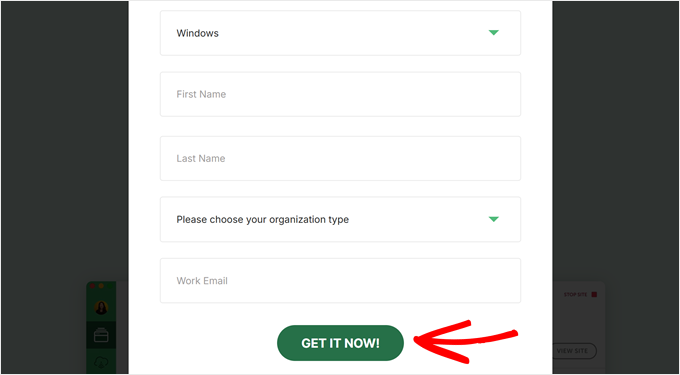
Dopo aver inserito i dati, è sufficiente fare clic sul pulsante “Ottieni ora”.
Successivamente, il software verrà scaricato automaticamente nel computer. Altrimenti, è possibile fare clic sul link “clicca qui” per avviare il download.
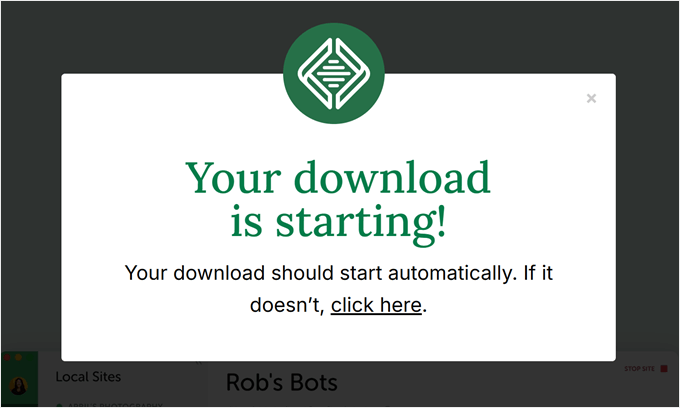
Una volta scaricato il file, avviate la procedura guidata di installazione.
A questo punto, dovrete selezionare se volete installare il software per tutti gli utenti o solo per voi.
Una volta selezionata un’opzione, fare clic sul pulsante “Avanti”.
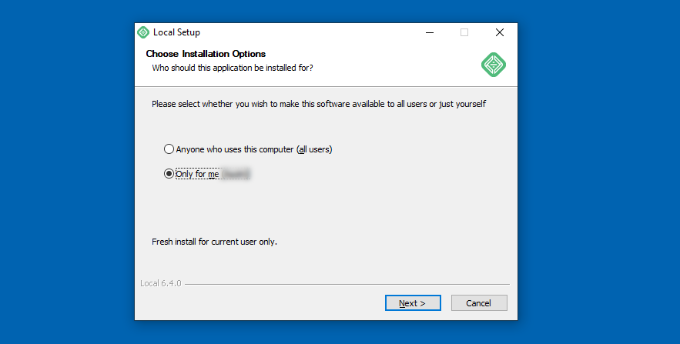
Nel passaggio successivo, è possibile selezionare la “cartella di destinazione” in cui verrà installato il software.
È sufficiente fare clic sul pulsante “Sfoglia” per impostare il percorso e quindi fare clic sul pulsante “Installa”.
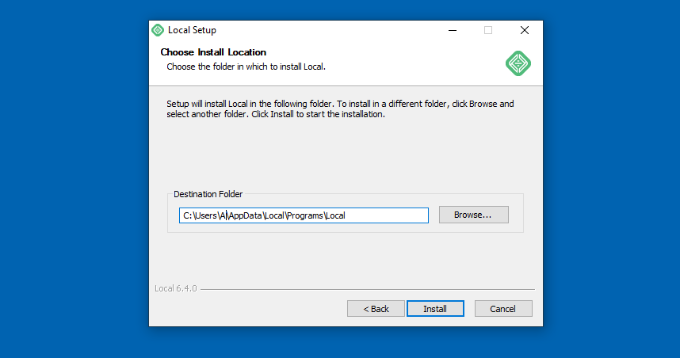
Il software Local WP viene ora installato sul computer Windows.
Una volta terminato, è possibile selezionare la casella di controllo “Esegui in locale” e fare clic sul pulsante “Fine” nella procedura guidata di installazione.
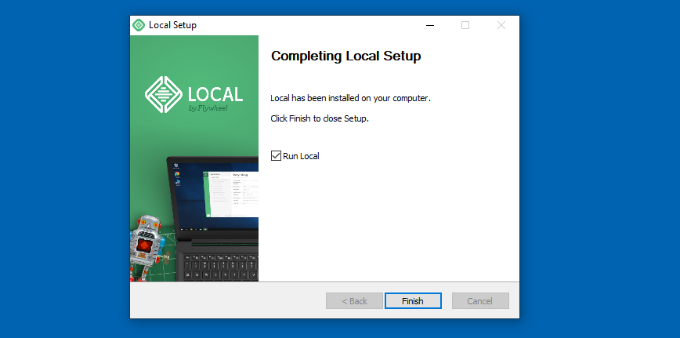
A questo punto il software si avvia sul dispositivo Windows.
Il passo successivo consiste nell’aggiungere un nuovo sito web locale. Per farlo, è sufficiente fare clic sul pulsante “+” in basso.
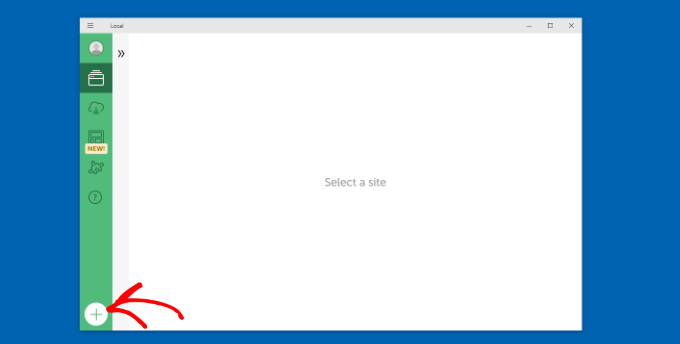
Successivamente, è possibile creare un sito nel software Local.
Selezionare l’opzione “Crea un nuovo sito” e fare clic sul pulsante “Continua”. È possibile creare il sito partendo da un blueprint o da un file di sito esistente, ma a scopo dimostrativo sceglieremo la prima opzione.
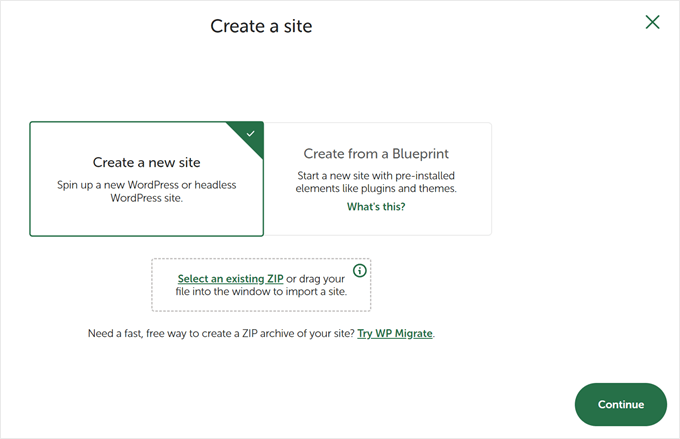
Successivamente, è possibile inserire un nome per il sito web locale, ad esempio “Il mio sito WordPress”.
Sono disponibili anche opzioni avanzate in cui è possibile inserire il dominio del sito locale e il percorso del sito locale. Per impostazione predefinita, il dominio utilizzerà il titolo del sito web, ma separato da trattini.
Una volta terminato, è sufficiente fare clic sul pulsante “Continua”.
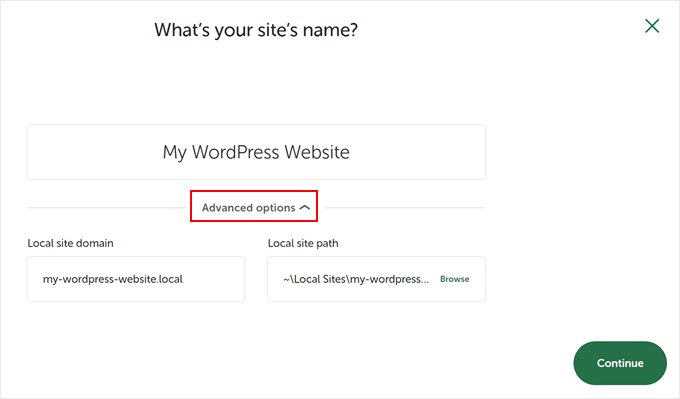
Successivamente, è necessario scegliere un ambiente per il sito web locale.
È possibile utilizzare l’ambiente “Preferito”, in cui il software selezionerà automaticamente la versione di PHP, il server web e la versione di MySQL. D’altra parte, si può anche selezionare “Personalizzato” e inserire i dettagli dell’ambiente.
Local WP offre le ultime versioni di PHP. Per quanto riguarda il server web, è possibile scegliere tra Nginx e Apache. È inoltre possibile scegliere tra MySQL o MariaDB per i database.
Si noti che alcune versioni di PHP, server web e database richiedono il download di alcune dipendenze per funzionare correttamente.
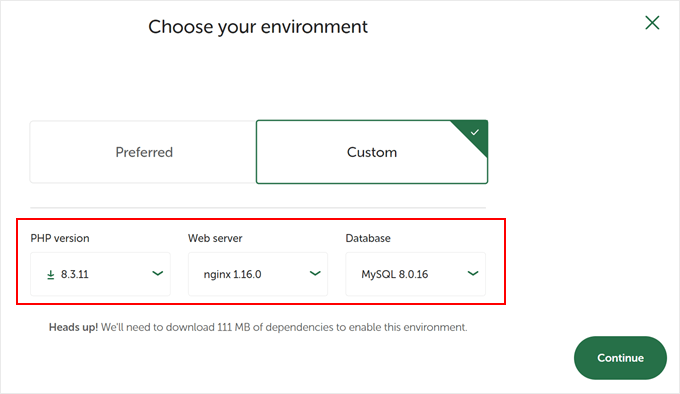
Successivamente, è possibile inserire un nome utente e una password di WordPress per il sito web locale. Inoltre, è possibile scegliere un indirizzo e-mail di WordPress per ricevere tutte le notifiche via e-mail.
Oltre a questo, c’è un’opzione avanzata in cui il software vi chiederà se avete una rete WordPress multisito. In caso contrario, basta fare clic su “No”.
Dopo aver inserito questi dati, è sufficiente fare clic sul pulsante “Aggiungi sito”.
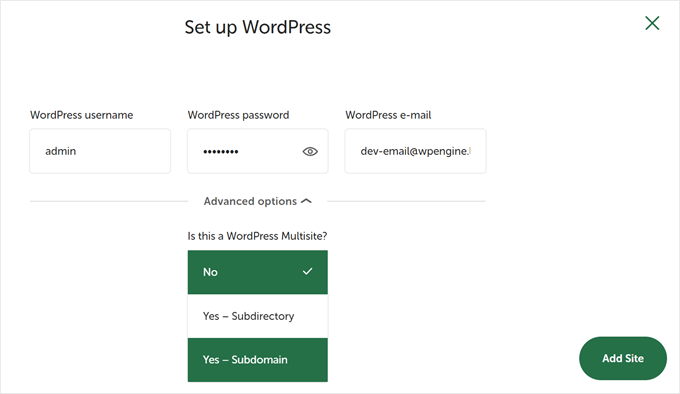
Il software installerà ora WordPress e configurerà il vostro sito web.
Per avviare il sito web locale, fare clic sul pulsante “Avvia sito” nell’angolo in alto a destra.
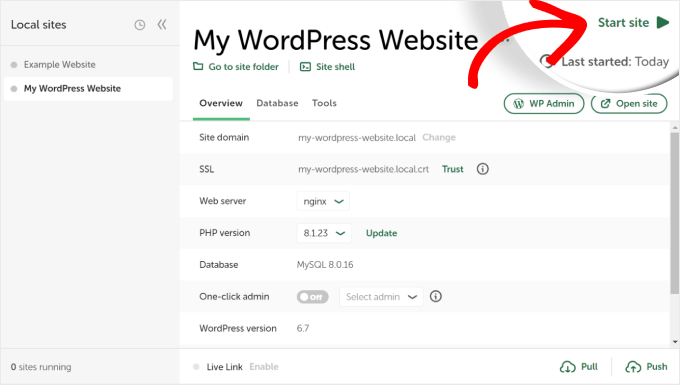
Quindi, fate clic sul pulsante “WP Admin” e vedrete la pagina di accesso all’amministrazione di WordPress.
È sufficiente inserire il nome utente e la password immessi in precedenza durante la configurazione del sito web locale, quindi fare clic sul pulsante “Accedi”.
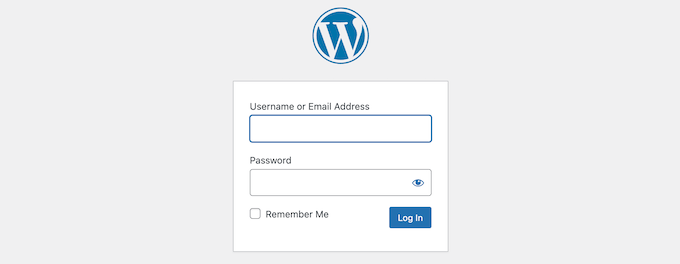
Ora è possibile modificare il sito web locale sul computer Windows.
Una volta terminato, non dimenticate di fermare il sito web dal software Local WP facendo clic sul pulsante “Stop site”.
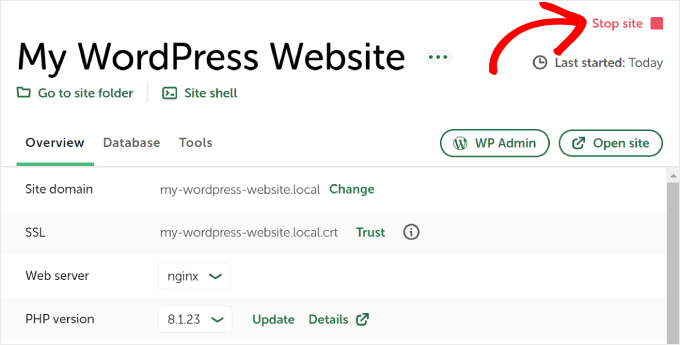
Suggerimento: se si desidera saltare il processo di login, è possibile abilitare il login dell’amministratore con un solo clic in Local WP.
Per farlo, basta tornare alla dashboard di WP locale e attivare il pulsante “Amministratore con un solo clic” fino a quando non appare la dicitura “On”. Quindi, nel menu a discesa, selezionare l’utente amministratore che può utilizzare questa funzione di accesso con un solo clic.
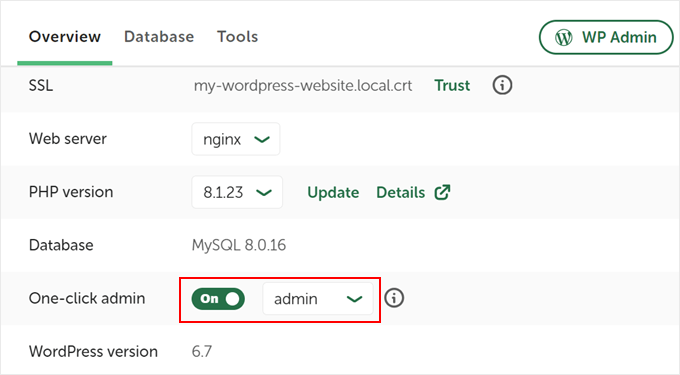
Alternativa: Usare WordPress Playground per testare temi, plugin e altro ancora
WordPress Playground è uno strumento innovativo che consente di sperimentare WordPress direttamente nel browser web. Si tratta di una sandbox virtuale in cui è possibile provare nuovi temi, plugin e funzionalità di WordPress senza influire su alcun sito web reale.
WordPress Playground si differenzia da un ambiente WordPress locale per diversi aspetti fondamentali.
Innanzitutto, non richiede l’installazione sul computer e si ripristina dopo ogni utilizzo, a differenza delle installazioni locali permanenti. È possibile accedervi da qualsiasi dispositivo dotato di browser, mentre le installazioni locali sono legate a un solo computer.
Mentre WordPress Playground è ideale per test e apprendimento rapidi, un ambiente WordPress locale sul vostro computer Windows offre maggiore flessibilità per progetti di sviluppo a lungo termine.
Per una guida dettagliata, consultate la nostra guida su come utilizzare WordPress Playground nel browser.
Ho installato WordPress sul mio computer Windows, e ora?
Ora che avete WordPress sul vostro computer, ecco alcune cose che potete fare:
- Imparate i suggerimenti e i trucchi di base di WordPress per utilizzare meglio il vostro sito.
- Provate diversi temi di WordPress per vedere come può apparire il vostro sito.
- Installate e testate i plugin WordPress indispensabili per aggiungere nuove funzionalità al vostro sito.
- Imparate a risolvere gli errori più comuni di WordPress da soli.
- Provate diversi page builder drag-and-drop per dare al vostro sito un aspetto gradevole.
- Imparate a reimpostare la password di amministrazione di WordPress su localhost per recuperare l’accesso al vostro sito.
- Impostate flussi di lavoro automatizzati per semplificare la gestione del sito.
- Imparate a conoscere la sicurezza di WordPress per mantenere il vostro sito al sicuro dagli hacker.
- Spostate il vostro sito WordPress locale su un server live quando siete pronti a condividerlo con tutti.
Speriamo che questo articolo vi abbia aiutato a capire come installare WordPress in locale su un computer Windows. Potreste anche consultare il nostro articolo su come installare WordPress in locale su un computer Mac e la nostra guida definitiva alla creazione di un sito di staging per WordPress.
Se questo articolo vi è piaciuto, iscrivetevi al nostro canale YouTube per le esercitazioni video su WordPress. Potete trovarci anche su Twitter e Facebook.





Leone Agoya
Thank you for this article. Very helpful and it works.
Vivek Sharma
Best tuts awesome explanation , best website
WPBeginner Support
Hey Vivek, glad you like our website. Don’t forget to join us on Twitter for more WordPress tips and tutorials.
Admin
Stephen Rea
Thank you… It feels great to be learning new powers.. WP and WAMP now on desktop… Now to learn WP !
Dave
Great walk through!!! Thanks for the assist!!!
Elaine
Wow, thanks sooo much. It helped me a lot.
Manuel
Absolutely outstanding! Had an issue with C++ 13 & 14 but it was so well explained and pointed me in the right direction that I was able to solve it and now I have a development WordPress environment on my Window 10 laptop. THANK YOU VERY MUCH
Jonathan
Do I need have basic in knowledge coreldraw and or photoshop to become a professional web designer.
Thanks for your sincere answer.
WPBeginner Support
It will help greatly. Specially Photoshop.
Admin
Karthik
Really useful and thanks very much..:)
Michael Gyori
Greaet tutorial, thanks!
One suggestion. Mention the Skype Port 80 issue right at the point when it would be encountered in your tutorial. Having it mentioned at the end was not helpful because I already spent considerable time trying to figure out what was going wrong. A simple note saying: “If your browser screen is blank when selecting phpMyAdmin, then you may have a conflict with Skype (see below).”
mark k
Thx for the tutorial – ran in to problems starting WAMP (blank page on localhost/phpmyadmin), on wins 10 www service was running stopping apache, so ran services.msc and stopped that.
Only other problem happened when wp tried to create config – by default it self completes txtBox with “password” so just remember to delete it. simple fix but had me stumped for 2 mins.
once again thx
Frank George
please i need urgent help as i would love to move my site live….i am running wordpress through my local host using Microsoft web matrix through IIS7…how do i do it please…i need help urgently!
ahmed
Hi
I have plant to installed WordPress on wamp windows based server.who is right person to contact if I find any problem. Please let me know.
Thanks in advance.
Ahmed
vijay
i installed wordpress using bitnami software.
i also tried using wamp both are awesome.
Johari
Thank you for simplifying the manual. The steps you provided are easy to follow. Keep posting great articles!
cornel
great job , thank you
Vikash Gupta
Thank you for providing nice guidance.
It worked for me excellently.
Ahmed
When i tried to start wamp, its giving me an error that vcruntime.dll is missing… Please any solution?
Mayur
After clicking on phpmyadmin showing error.
The webpage cannot be found
Plz help me..
Ruben Tahir
Trying to run phpMyAdmin for the first time, I am prompt to enter user name and password. I suppose there must be a default user name a password. What are they or how to setup my own?
Ruben Tahir
Just found out by simply googling. the username is root and no password.
You should mention that in your tutorial.
J Robinson
My WAMP-64 was installed some time ago on my D: drive. I just added WP. When I point the browser to http://localhost/wp-admin/ (changed the WP folder name back), I get:
Warning: require_once(D:\wamp64\www/wp-load.php): failed to open stream: No such file or directory in D:\wamp64\www\wp-admin\admin.php on line 31
and
Fatal error: require_once(): Failed opening required ‘D:\wamp64\www/wp-load.php’ (include_path=’.;C:\php\pear’) in D:\wamp64\www\wp-admin\admin.php on line 31
Should I just delete everything and start over, or is there a configuration to fix this?
manjeet kaur
hi sir I want to learn word press .can I learnt it online ? my future depend on it
Dipankar Ray
Thanks for the step by step info. However, I am not sure how to create a Database as very time I click on the Wamp icon and then phpMyAdmin, I am getting a blank new browser window with ‘http://localhost/phpmyadmin as the URL..
Therefore,I can’t proceed to the next step which is to click on Databases and thereafter create a database for WordPress.
Please help and point out if I am not on the right path.
Thanks.
WPBeginner Support
Try adding a slash at the end of URL like this:
http://localhost/phpMyAdmin/
Admin
Dipankar Ray
Thanks for your suggestion of using the URL above. I had overcome my previous issue and was able to proceed. However, after that I came across other issues like MySQL errors and decided to uninstall WAMP server from my computer.
By the way, my OS is Windows XP.
Now on trying to re-install after downloading this software I am receiving the following error message. ‘ Aestan Tray Menu has encountered a problem and needs to close.We are sorry for the inconvenience.’. This has happened over three times. Thanks.
Please help as I am not sure where I am erring.
WP Complete Beginner
Pretty sure that you have Microsoft IIS running which is causing this mess. Happened to me. Go to the WAMP > Apache > Test Port 80 option.
It will blurt out something like Port 80 wrong service is running. The real service that’s running is MS IIS X.0
Launch cmd as admin and type iisrest / stop in the command line.
Then go to WAMP > Apache > Service Administration > Install Service
Finally, Then go to WAMP > Apache > Service Administration > Start Service.
It should work! Let me know if my comment helped you.
Jun Allan
Thank you!
Fawaz
Thanks a lot. Had to fix some errors and finally it worked. Very nice guide through. Already bookmarked.
Vassilis
How do I establish 2 or more sites on the same server (if possible)?
Thanks in advance
Krishna
Really useful and worked perfectly. Thank you so much..
ART
I’m an advanced beginner using Vista SP2. I think I am running both 32 and 64 bit. I had a big problem with VCRunTime140.dll missing error. First I tried Wamp 64bit, then Wamp newest 32bit, then confirmed VCRunTime140.dll was installed in my Windows\System32 folder and confirmed my updated Firefox was in the Programs(86) folder. Still had the *.dll missing error. Then tried the older Wamp 32bit. Problem solved.
2 more errors I made were to copy the WordPress folder without extracting it. Then deleted where I copied it and properly extracted it before copying. But I copied it to Wamp instead of Wamp\www
After I deleted it from the second wrong location, I copied it to Wamp\www and things worked great after that.
Hopefully a little helpful to call out some beginner errors to prevent others’ headaches.
Visata requires Wamp Version 2.5
Recently Wamp and Google Maps versions or settings have changed. Vista SP2 cannot run the latest Wamp, Stay with Version 2.5, specifically MYSQL 5.6.XX (I found xx=17 but some places say xx=26 is available.)
Thank you so much for these instructions!! Other lists of instructions are very difficult and not very useful.
Vianney kirumira
Thank u so much guyz. really you have made my day!. At least
Iris India
Excellent ! Thanks for your step by step instructions
Sid
Probably being dumb, but how do i see my web site project again and work on my site? To open it again I selected the ‘wamp’ icon, it opened a dashboard where I could see my project folder, I double clicked to open it, but instead of my site I got a page that said error my page cannot be found. I could not see the wordpress dashboard when I selected the wamp icon or any option to open wordpress. Can you please advise? Thanks.
Michael
Type localhost/site-name in your browser. To view your admin type localhost/sitename/wp-admin
Nicko Johnson
After clicking on phpMyAdmin its saying the site can’t be reached. What could be wrong?
Sid
Just want to say thank you! I have never done anything like this before and your steps were very useful and easy to follow
NOURI
when I try to install WAMP, it gives me error msg
JP
I followed instructions, yet when I attempt to open the browser with:
http://localhost/mysite/
I get a 404 file not found. Any hints as to what is going on? Thanks.
WPBeginner Support
The mysite directory is not found in the WAMP web folder.
Admin
kittyket
and what do you have to do then?
WPBeginner Support
It depends. May be a user has installed WordPress in their htdocs or www directory. Or may be they created the mysite folder elsewhere and WAMP can’t find it in the www directory.
Maya
Struggled a bit with Wampserver installation but finally everything went smooth. Thanks for the step-by-step explanation.
WPBeginner Support
Glad you found it helpful.
Admin
puri shanker dhobi
how to open a php template in wordpess using wamp server
Gold
Thank you so much!!!! You’re all shades of amazing.. This tutorial was super super helpful. Everything worked perfectly. Thanks again!
veena
after wp_config file it is sudenly showing following error.
Error establishing a database connection
I have created a database , mysql , apache , php are all working, how find out solution for this?
Suzi
I was getting the same error because I was not using a password, and I forgot to remove the word “password” where it asks for MySQL password on the previous page!
Erling Bergan
I have followed the instructions, and everything has looked fine. I have clicked on the Wampserver icon, and then clicked on phpmyadmin. A browser window opens, but there is no phpMyAdmin in it. The web page is blank. Could you give me a hint of what may be wrong?
Suzi
I was having the same issues .. there are so many reasons that this could be happening. did you follow ALL of the instructions, including the VISUAL downloads and skype and port 80 issues? I got to the point where my icon was green and still would not work, so I uninstalled it and used the 32 bit version even though I have 64 bit on my pc. Then it worked!
Jimmy Karago
Thanks so much was lost but, this helped me a lot
soheib
thank youuuuu really helped!!!!!!!!
Mxolisi Maphosa
Thank you very much, this helped me so much.
ana
Great tutorial! It really helped me. I’ll be following you.
Jeremy
Hi, what if I have an instance of Acquia Dev Desktop (Drupal) on my local machine? Installing this wont be an issue?
Thanks
Paul Gomez
Hello, right now I am trying to set the WAMPserver, but in i see 4 versions 2 for 32 Bits and 2 for 64 Bits. Which of the two versions should I pick? I am a bit confused what the difference is from the 2 versions. I see the Apache, PHP and MySQL versions are different but I am not sure.
WPBeginner Support
They are basically the same. Most modern computers have 64bit architecture. If you are using an older machine then try 32bit version, other wise try 64bit version.
Admin
Paul Gomez
I understand, but that was not my question. Please read my original message.
Jason
This has to do with the size of the data types the processor can handle and the size of the memory addresses it can hold in it’s register. 64 bit applications can utilize more RAM because they can utilize exponentially more of those addresses, but unless you are writing your own ‘big data’ type of applications or using plugins that need the extra memory then it’s almost completely irrelevant to you. You won’t notice the difference either way, so just pick one.
Phil
Any answer on this? I have the same question. I know I want 64 bit, but what PHP version should I choose?
HV
The two 64bit installs have different software versions.
Apache : 2.4.17 MySQL : 5.7.9 PHP : 5.6.16 on one
and Apache : 2.4.9 MySQL : 5.6.17 PHP : 5.5.12 on the other.
The two 32 bit versions are similar
They are giving you options in case your development environment
needs a particular version of Apache, PHP or MySQL
Prasad Sagare
After clicking on phpmyadmin show error.
IIS 8.5 detailed error-404 not found.
Plz help me..
David
I get the same error 404 page when clicking phpmyadmin. Any resolution here? I do not have skype on this computer.
Luc
After numerous failures, this instruction worked just fine! Thanks.
dicegeorge
Thanks,
that worked without a hitch,
i’ve been wanting to do this for ages!
Michael
It is not clear to me whether I must set up a database first, or can I simply import my current live back up of the blog, and then work on it locally.
I sort of expected to import the existing word press blog to my local hard disk, and the import process will then create all the tables and the databases.
Thanks
Ron
Thank you. This great page of info REALLY helped !!!
Prashant Menase
Thank you for easy steps!!! Helped me lot! keep adding………….